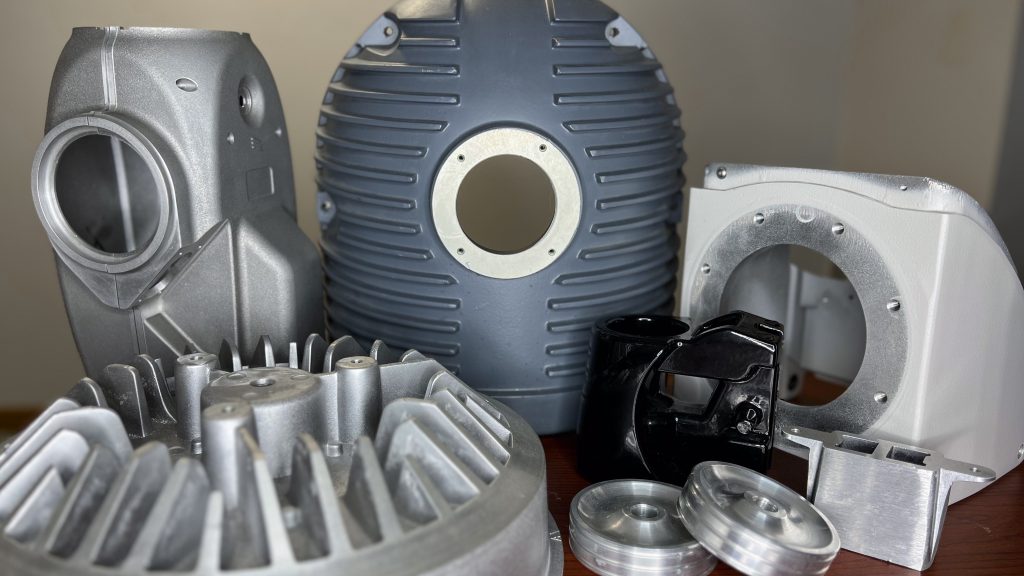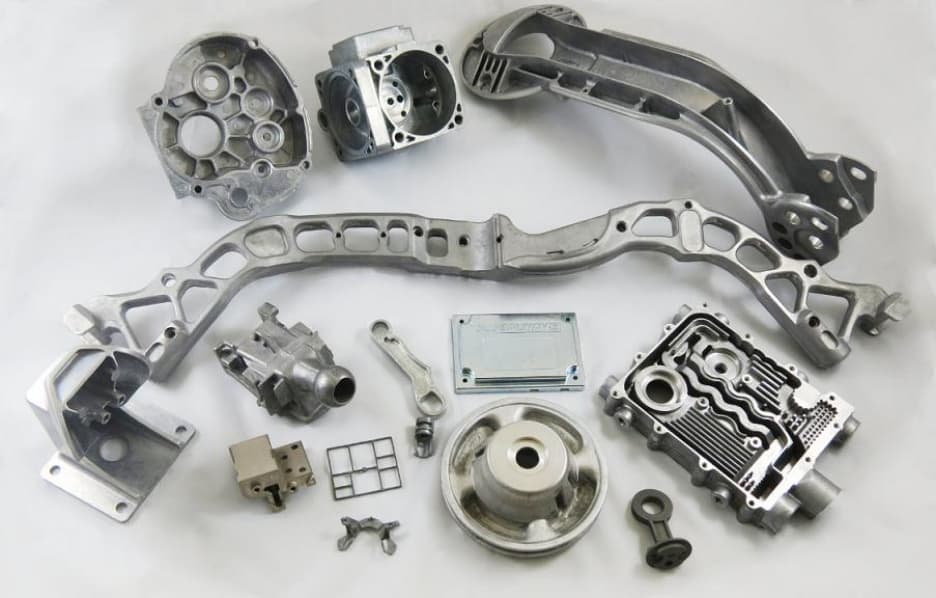Understanding the process behind high-quality Aluminum Castings
Wiki Article
Checking Out the Versatile Makes Use Of and Applications of Light Weight Aluminum Castings in Modern Industries
Light weight aluminum spreadings have actually ended up being important to various contemporary markets because of their distinct residential properties. They supply substantial benefits in weight reduction, thermal conductivity, and corrosion resistance. From automotive developments to applications in durable goods and construction, their versatility is impressive. The true extent of their impact extends past prompt benefits, hinting at more comprehensive effects for sustainability and effectiveness. What lies in advance for light weight aluminum castings in an ever-evolving commercial landscape?Automotive Market Innovations
The auto market has significantly welcomed aluminum spreadings to improve automobile performance and effectiveness. By making use of aluminum, manufacturers can create lighter components, which add to boosted fuel economy and minimized discharges. Trick applications include engine blocks, transmission cases, and architectural parts, where the product's strength-to-weight ratio provides resilience without including excess weight.Aluminum spreadings likewise supply remarkable thermal conductivity, which assists in much better warmth dissipation, thus enhancing engine efficiency. Improvements in casting innovations, such as die spreading and sand spreading, enable the production of intricate geometries, permitting for innovative designs that enhance room and functionality.
The recyclability of aluminum lines up with sustainability objectives in the auto sector, advertising eco-friendly methods. As the sector proceeds to introduce, making use of aluminum spreadings is likely to increase, driving more advancements in car style and effectiveness.
Aerospace Applications and Improvements
While the aerospace market remains to prioritize weight reduction and fuel effectiveness, light weight aluminum castings have actually emerged as a critical material option for numerous applications. Their lightweight nature, coupled with high strength-to-weight ratios, allows for considerable enhancements in aircraft performance and efficiency. Aluminum spreadings are generally made use of in architectural parts, such as body frameworks and wing parts, where decreasing weight is vital.Recent advancements in light weight aluminum spreading modern technologies, including boosted alloy formulas and accuracy spreading methods, have actually additionally improved the product's efficiency capabilities. These innovations allow the production of complex geometries and detailed designs while maintaining structural integrity. In addition, aluminum's superb corrosion resistance warranties durability and reliability in extreme aerospace environments.
As the aerospace field progressively accepts sustainability, aluminum spreadings offer a recyclable option that aligns with green practices, making them an essential element in the growth of next-generation aircraft.
Durable Goods and Everyday Products
As consumers progressively look for light-weight yet durable products for day-to-day products, aluminum spreadings have actually acquired appeal in different durable goods. The distinct properties of aluminum, including its resistance to rust and superb thermal conductivity, make it a suitable choice for products like kitchenware, house appliances, and outside gear. As an example, aluminum cast pans and pots give also warmth distribution, improving cooking efficiency. Furthermore, the usage of aluminum in products such as bicycle frameworks and baggage ensures an equilibrium in between stamina and portability. Suppliers value light weight aluminum castings for their versatility, as they can be quickly molded into complex shapes while maintaining structural integrity. Moreover, the capability to recycle aluminum without weakening its residential or commercial properties lines up with expanding customer choices for lasting products. Generally, aluminum spreadings are important to the production of long lasting, functional, and visually pleasing durable goods, fulfilling the demands of modern-day way of livings.Building and Architectural Uses
Light weight aluminum spreadings have come to be an important part in building and architectural layout, especially due to their toughness and lightweight nature. These residential properties make light weight aluminum a perfect selection for different applications, consisting of structural components, facades, and decorative attributes - Metal Castings. Engineers and home builders significantly utilize aluminum spreadings for window structures, doors, and roof covering systems, improving both functionality and appearances. The material's resistance to deterioration further prolongs its lifespan, decreasing upkeep costs and guaranteeing durability in diverse ecological problemsIn addition, aluminum can be quickly built into elaborate styles, permitting for innovative building expressions. Its adaptability assists in the production of customized pieces that fulfill specific layout needs, from ornate barriers to complicated assistances. As sustainability becomes a priority, light weight aluminum's recyclability adds to its appeal in eco-friendly construction methods. Generally, light weight aluminum castings are transforming the building and construction market by supplying light-weight, sturdy, and visually appealing services.
Electric and Electronic Components
Light weight aluminum castings play a vital function in the production of lightweight electrical enclosures, which boost transportability and performance in numerous applications. Furthermore, their exceptional thermal conductivity makes them suitable for warm sinks, making sure peak efficiency and durability of electronic parts. Light weight aluminum's conductive residential properties add to its use in various electric conductors, emphasizing its value in contemporary technology.Light-weight Electrical Units
Lightweight electrical enclosures play a necessary function in safeguarding sensitive digital elements from ecological aspects and physical damage. Constructed from light weight aluminum castings, these units are valued for their strength-to-weight ratio, making them excellent for different applications throughout industries. Their lightweight nature aids in minimizing general system weight, which is crucial in portable and mobile electronic devices. Additionally, aluminum's rust resistance boosts durability, expanding the lifespan of the enclosed parts. The capacity to mold aluminum into intricate shapes enables tailored layouts, satisfying certain needs while guaranteeing reliable heat dissipation. Additionally, these rooms can be conveniently incorporated into existing systems, offering versatility and convenience in modern technological atmospheres. Generally, light-weight light weight aluminum enclosures significantly add to the performance of digital tools.Heat Sinks and Conductors
While many materials are used in electronic components, aluminum spreadings stick out for their performance in warmth monitoring as warm sinks and conductors. Their superb thermal conductivity enables reliable warmth dissipation, which is crucial in avoiding the overheating of electronic gadgets. Light weight aluminum's lightweight nature better boosts its suitability for applications where weight is a considerable element, such as in aerospace and automobile industries. In addition, aluminum castings can be easily built right into complicated shapes, giving layout adaptability for optimizing thermal performance. The corrosion resistance of light weight aluminum additionally adds to the long life and dependability of these elements in different environments. As technology advances and devices become extra small, the demand for reliable heat management remedies, like light weight aluminum castings, remains to grow.Marine Industry Application
The marine sector progressively relies on light weight aluminum castings for their outstanding sturdiness and corrosion resistance. These residential or commercial properties make light weight aluminum an ideal selection for different applications, consisting of boat hulls, engine parts, and marine equipment. The lightweight nature of light weight aluminum spreadings allows improved fuel efficiency and less complicated ability to move in watercraft, which is essential for both business and recreational vessels.
Light weight aluminum castings also give considerable cost advantages due to their lengthy lifespan and reduced upkeep demands, lowering the overall operational expenditures for marine operators. Furthermore, the flexibility of aluminum permits intricate layouts that can satisfy details performance requirements.
Suppliers navigate to this site in the marine field utilize advanced casting strategies to create intricate shapes, making sure that components satisfy strenuous safety and security and performance criteria. As the demand for high-performance aquatic vessels expands, aluminum castings are placed as a key material in boosting the functionality and durability of aquatic tools.
Sustainability and Recycling in Aluminum Casting

Light Weight Aluminum Recycling Process
Reusing light weight aluminum plays a vital role in lessening environmental effect and preserving resources within the spreading industry. The aluminum reusing procedure begins with the collection of scrap aluminum, which can consist of old parts, manufacturing waste, and post-consumer products. This scrap is then arranged, cleansed, and shredded right into small pieces to assist in melting.As soon as prepared, the aluminum scrap is melted in a heating system at reduced temperatures than main light weight aluminum production, significantly minimizing power intake. The molten aluminum is then cast right into ingots or various other forms for reuse in numerous applications - Metal Castings. This closed-loop system enables for the effective healing of light weight aluminum, maintaining its homes while minimizing the demand for virgin products. The recycling process is a vital part of lasting methods in light weight aluminum spreading.
Environmental Advantages
While aluminum spreading plays a crucial duty in various industries, its environmental advantages are specifically exceptional concerning sustainability and resource preservation. The light-weight nature of aluminum contributes to energy efficiency in transport, lowering fuel consumption and emissions. In addition, light weight aluminum casting promotes the usage of recycled materials, significantly lowering the power required for manufacturing contrasted to primary light weight aluminum. This reusing procedure lessens waste and reduces the ecological effect connected with mining and refining basic materials. Additionally, aluminum is 100% recyclable without destruction of its buildings, advertising a lasting lifecycle. By picking aluminum spreading, markets can greatly reduce their carbon impact while promoting resource efficiency, making it an essential selection in the search of eco-friendly manufacturing techniques.Closed-Loop Systems

Often Asked Inquiries
What Are the Trick Benefits of Aluminum Castings Over Various Other Products?
Aluminum castings provide light-weight properties, outstanding rust resistance, and high strength-to-weight proportions. They can be conveniently built right into complex shapes, supply great thermal and electric conductivity, and are cost-efficient, making them preferable over many alternative materials.Exactly how Is the Aluminum Spreading Process Eco-friendly?
The aluminum casting process is eco-friendly as a result of its recyclability, reduced power imp source intake, and decreased waste manufacturing. Its capability to make use of recycled materials lessens the carbon footprint, promoting sustainability within manufacturing techniques.What Prevail Obstacles in Aluminum Casting Manufacturing?
Usual difficulties in light weight aluminum casting production consist of preserving dimensional accuracy, managing thermal tightening, protecting against issues like porosity and incorporations, making sure appropriate mold layout, and maximizing production performance while decreasing product Clicking Here waste and environmental impact.Just How Do Light Weight Aluminum Castings Compare in Price With Various Other Manufacturing Approaches?
Light weight aluminum castings usually use competitive prices contrasted to other making techniques, particularly for medium to high-volume production. Their reduced preliminary tooling expenses and reliable material usage can lead to favorable business economics with time.What Future Patterns Are Anticipated in Light Weight Aluminum Casting Innovation?
Future trends in light weight aluminum casting innovation are anticipated to consist of developments in automation, boosted alloy make-ups, enhanced reusing methods, and the combination of 3D printing, all aimed at boosting performance, decreasing prices, and reducing ecological impact.Current advancements in light weight aluminum spreading technologies, consisting of improved alloy formulas and accuracy spreading techniques, have actually better enhanced the product's efficiency capabilities. Aluminum spreadings have actually become a necessary part in construction and building layout, specifically due to their strength and lightweight nature. The aluminum recycling procedure begins with the collection of scrap aluminum, which can include old elements, making waste, and post-consumer items. Once prepared, the light weight aluminum scrap is thawed in a heater at lower temperatures than key aluminum production, considerably reducing energy consumption. Furthermore, aluminum spreading assists in the usage of recycled products, substantially lowering the energy needed for manufacturing contrasted to key light weight aluminum.
Report this wiki page